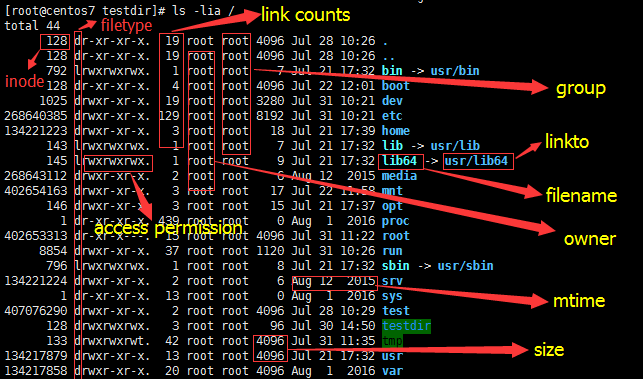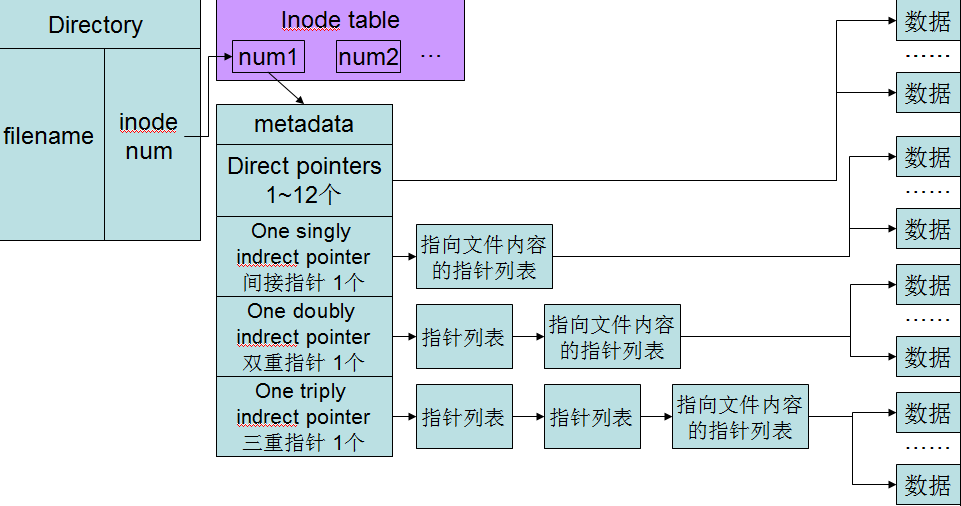inode 原理解析
文件系统除了文件内容(file content)之外,还依赖于描述这些文件的数据结构(data structures),即元数据metadata。每个文件都会分配一个inode,每个inode都有一个编号inode number。 Inode存储了文件相关信息,如必备属性(by POSIX): * Size * DeviceID * UserID * GroupID * file access mode:文件类型及拥有者owner、群组group、其他人对文件的操作权限 * Timestamps:atime(access time),ctime(change time),mtime(modify time) * link count:统计指向文件的硬链接(hard links)数量 * Pointers:指向磁盘上存储文件内容的数据库块(blocks)地址上述信息可以用 stat 命令获取文件的inode号及inode中的信息,即该文件的状态描述信息。
[root@centos7 testdir]# stat aa File: ‘aa’ Size: 0 Blocks: 0 IO Block: 4096 regular empty file Device: 805h/2053d Inode: 131 Links: 1Access: (0644/-rw-r--r--) Uid: ( 0/ root) Gid: ( 0/ root) Context: unconfined_u:object_r:etc_runtime_t:s0 Access: 2016-07-30 14:16:14.343586884 +0800Modify: 2016-08-01 16:44:29.000000000 +0800Change: 2016-07-30 14:17:58.446580298 +0800 Birth: -
通过df -i 命令可以查看每个硬盘分区的inode 总数和已经使用的数量。
[root@centos7 testdir]# df -iFilesystem Inodes IUsed IFree IUse% Mounted on /dev/sda2 104857600 120034 104737566 1% / devtmpfs 229977 389 229588 1% /dev tmpfs 233586 7 233579 1% /dev/shm tmpfs 233586 560 233026 1% /run tmpfs 233586 13 233573 1% /sys/fs/cgroup /dev/sda5 20971520 11 20971509 1% /testdir /dev/sda1 204800 330 204470 1% /boot tmpfs 233586 21 233565 1% /run/user/0/dev/sr0 0 0 0 - /run/media/root/CentOS 7 x86_64
在实际中可能会遇到磁盘满了的警告,此时应同时使用 df -i 和 df -h 命令来查看原因究竟是inode达到上限还是空间不足导致的。
通过 ls -i 命令可以查看每个文件/目录的inode num等。
在很多系统中,inode number在系统初建时就有一个固定的最大值,这也限制了文件系统的文件数量。通常inode大概会暂用1%的磁盘空间。 inode number 是磁盘确定位置上存储的inode table的索引。通过inode number,内核驱动可以获取inode存储的内容,包括文件存储位置。 说明: * inode 不存储文件名,仅包含上述其他元数据metadata * 目录 实际上是一个复合结构的映射列表,其中每条信息都包含了 filename 及其对应的 inode number * 驱动 先到文件夹中找到 filename,再将 filename 转换为inode number * 每个分区有自己独立inode table,因此inode num在不同的磁盘分区上是可重复的,但在同一分区内是唯一的 inode的结构和工作模式如下: In the past, the structure may have consisted of eleven or thirteen pointers, but most modern file systems use fifteen pointers. These pointers consist of (assuming 15 pointers in the inode): * Twelve pointers that directly point to blocks of the file's data (direct pointers) * One singly indirect pointer (a pointer that points to a block of pointers that then point to blocks of the file's data) * One doubly indirect pointer (a pointer that points to a block of pointers that point to other blocks of pointers that then point to blocks of the file's data) * One triply indirect pointer (a pointer that points to a block of pointers that point to other blocks of pointers that point t
cp & inode
1. 执行cp命令时,系统会找到一个可用的inode number,然后将数据写入到inode table 2. 新增一个目录项,将文件名映射到inode number上 3. 当inode number和inode table处理好了之后,系统才会将文件内容复制到新增的文件中
rm & inode
1. 系统会减去文件的link count数字,然后将对应的inode number标记为可使用 例如:aa 的 link count=1,当rm -rf aa后,aa 的 link count=0,其所对应的inode number也被回收标为可用2. 文件数据使用的block也会打上可以使用的“标签”(在blockgroup的bitmap中标识为1)3. 移除文件名称和目录项 注意: rm并不会真正删除数据,仅当有新的内容写入或格式化磁盘时,数据块中的数据才会丢失。
mv & inode
同一分区:不影响inode table(除了Timestamps)和 blocks,数据不移动
创建新的目录项,增加新的文件名与inode的映射关系
删除原有映射关系的目录项
软连接(symbolic link)
符号连接(软连接)指向了另一个文件,其本身有单独的inode num。(内部机制如何待查!)
特性: 1. 可跨分区创建软连接; 2. 可对目录创建软连接; 3. 修改/查看软连接,都实际上操作的是软连接指向的源文件; 4. 不会导致源文件 link count 的变化; 创建: cp -s source dest ln -s source dest
硬连接(hard link)
硬连接是有着 相同inode number 和 不同filename 的文件。
特性: 1. 文件有相同的 inode 及 data block; 2. 只能对已存在的文件进行创建; 3. 不能跨分区或驱动器创建硬链接(因为每个独立分区有自己独立的inode table); 4. 不能对目录进行创建,只可对文件创建; 5. 删除一个硬链接文件并不影响其他有相同 inode number的文件; 6. 创建后,源文件和硬连接文件的link count都增加; 7. 硬连接的文件类型表现为普通文件; 8. 修改硬连接/源文件内容后,查看任何一个都能看到修改; 创建: link filename linkname ln filename linkname
file 检查文件类型
语法
file [options...] [file...]
参数说明
| -b | 列出文件辨识结果时,不显示文件名称。 |
| -c | 详细显示指令执行过程,便于排错或分析程序执行 |
| -f | 列出文件中文件名的文件类型 |
| -F | 使用指定分隔符号替换输出文件名后默认的”:”分隔符 |
| -i | 输出mime类型的字符串 |
| -L | 查看对应软链接对应文件的文件类型 |
| -z | 尝试去解读压缩文件的内容 |
示例
[root@centos7 testdir]# file -b aaASCII text [root@centos7 testdir]# file -c aacont offset type opcode mask value desc [root@centos7 testdir]# echo /root > aa[root@centos7 testdir]# file -f aa/root: directory [root@centos7 testdir]# file -F "@" aaaa@ ASCII text [root@centos7 testdir]# file -i aaaa: text/plain; charset=us-ascii [root@centos7 testdir]# file dddd: symbolic link to `aa' [root@centos7 testdir]# file -L dddd: ASCII text
参考文档
转载于:https://blog.51cto.com/liangchao365/1832701
























 1012
1012











 被折叠的 条评论
为什么被折叠?
被折叠的 条评论
为什么被折叠?








